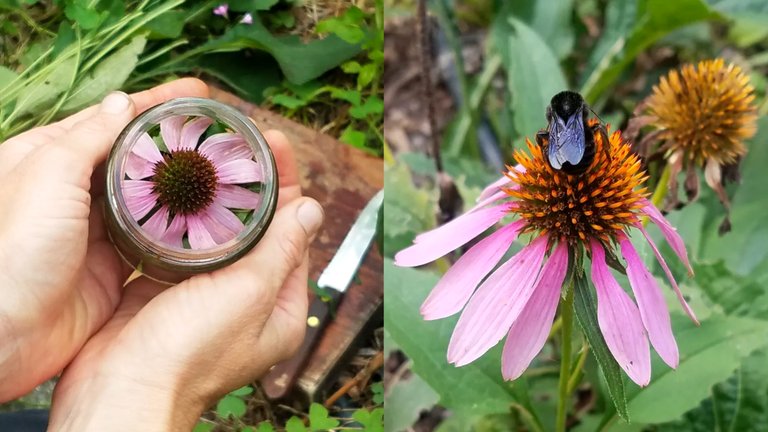I am attracted to common and abundant herbs rather than those that are exotic or hard to find. My herbal repertoire consists of rosemary, calendula, and yarrow - all plants that thrive in my little garden.
About five years ago I felt inspired to add another herb to the mix, one that is not commonly found in Argentina though very much sought after ~ Echinacea.

I started the plants from seeds that were passed onto me from a garden I used to work in while visiting my homelands of California. Once, echinacea was as common as any other wildflower in the plains of North America. Due to the centuries of popularity of this multi-use herb, however, populations in the wild have dwindled. In my efforts to make connections between where I am from and where I live now, planting this much beloved herb felt right.

So while I can't do much to re-echinacea it's native range, I can tend to a few plants in my garden and keep seeds to future spreading of this beautiful flower.

Making Echinacea Tinctures ~
There is so much conflicting information about when exactly to harvest echinacea. Here in Argentina I have heard of herbalists who harvest year old plants, using the leaves, and especially the flowers as the base of their tinctures. Most North American herbalists put an emphasis on harvesting the roots for medicine once they have reached three years maturity.
And when 2020/2021 rolled around with those years came a bought of illness. My plants were only a year or two old at that point and I felt that some medicine was better than none. I made tinctures with the entire plant (root, leaves, and flowers) of about half of those that I had planted to share with a few close friends and their kids, alongside other herbal remedies to support the immune system.

Since then, I have let the rest of the plants mature to three and four years of age, meanwhile planting seeds each year and tending to the volunteer echinaceas that pop up here and there.

From research online and in books I have found a lot of information stating that part of the immune supporting medicine can be found in the course leaves as well as the mature roots. And my friends who study flower essences say that there is spiritual healing to be found in the flowers too. And so, I use it all of the fresh plant in tinctures, focusing mainly on the three year old roots, adding a bit of the leaves, and a single flower to each tincture jar, then topping it all off with vodka.

(With the addition of the leaves this tincture is quite spicy, the leaves almost taste like oregano with a bit of pepper adding in too).
The Multiple Medicines of Echinacea ~
Anyone familiar with herbalism will have heard of echinacea's use in supporting the immune system. I love that echinacea has broken into mainstream culture and has a reputation for healing, even among those that don't tend towards herbal remedies for their illness.
I personally have used echinacea tinctures as preventative medicine when the season of illness settles in around the Christmas and New Year's holidays. I have also used small amounts of this tincture in my cats' water bowl to heal a persistent cough that one of my cats has had on and off for a few months. By small amount, I really do mean small! I add three drops to their full water bowl every other day, then discontinue after about two weeks.

According to Alma Hogan Snell an herbalist steeped in the traditional uses of echinacea from her Crow ancestry as well as study of "western" herbalism, echinacea root is very helpful in the case of snake bites. In her book "Crow Indian Recipes and Herbal Medicine" I read of how she re-habilitated a man who had been bitten by a rattle snake but was unwilling to go to the hospital. She washed the wound with echinacea liniment (a topical tincture) as well as administered the tincture orally with frequency. He recovered but, she suggests, that taking echinacea regularly and avoiding snake bites all-together is the best course of action.

It is spring here in Argentina. My echinacea plants are still so small and harvesting their roots will come much later on in the season. Typically they are to be dug up in fall when the energy is concentrated in their roots but before the winter makes them go into hibernation. When that time comes I plan to make all sorts of remedies with this wonderful herb!
Nunca había visto una abeja negra?? 🤔 es otro tiempo de insecto o edición de la foto @calendulacraft. Lindas imágenes gracias por compartir tu tratamiento saludos 😊🇨🇺👏
Es un abejorro! No hice ningun ediccion de las fotos, son asi ~ grandes, negros, y peludos por naturaleza. Viven en pequeños grupos en nidos debajo tierrs o en arboles. 🌳
Ohh, pues son bellos e interesantes. Gracias por la info @calendulacraft 😊👏
thanks so much!!
Congratulations @calendulacraft! Your post has been a top performer on the Hive blockchain and you have been rewarded with this rare badge
You can view your badges on your board and compare yourself to others in the Ranking
If you no longer want to receive notifications, reply to this comment with the word
STOP